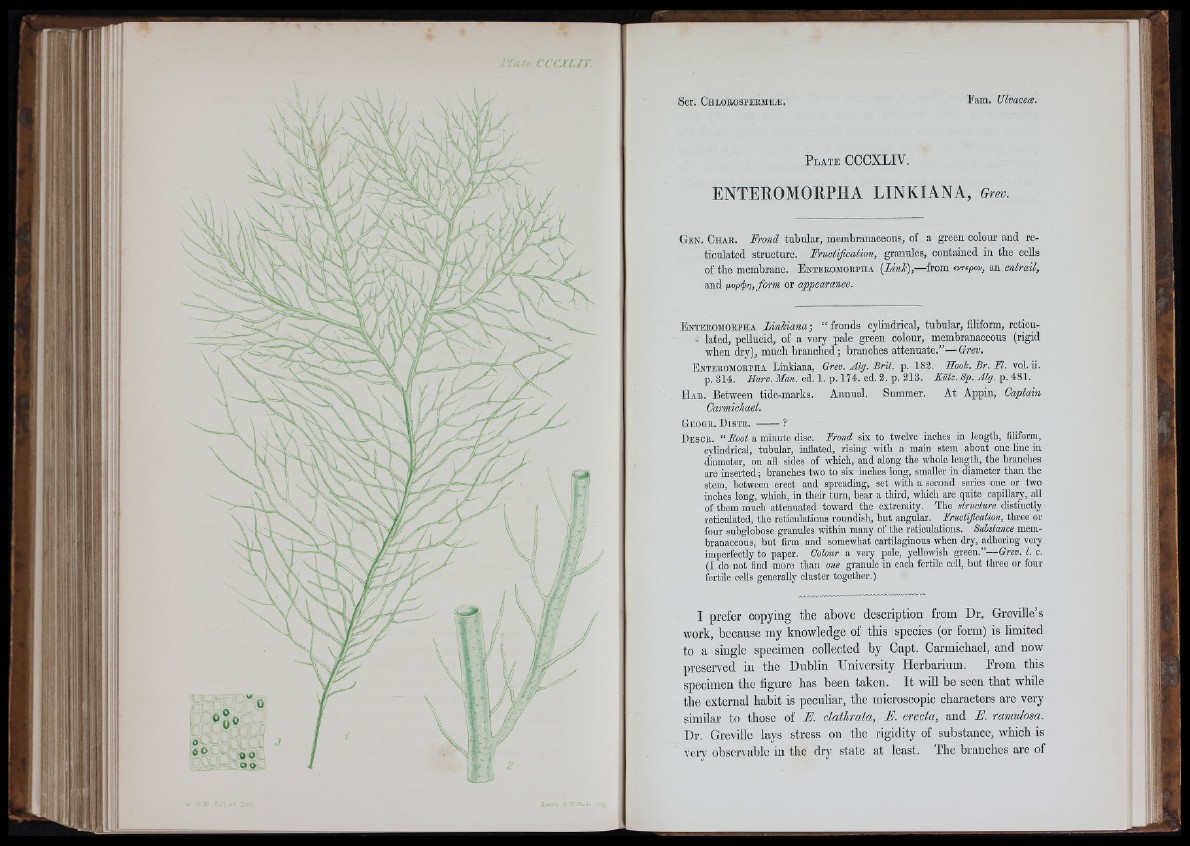
;S ) )V k, A M M , ’
A . ' ’ fakV V / - - -
\ II- a k /
k . G V è a i ' x < : r t Ÿ ' ! i i T k i f
'■■ V - ' M - M , '- 'i : \ I - ' i - ' ' ' ' . - ' v ' X \ V i s I \ :'.■ M / j
- ' i ' V x M AT > \ - I , T ‘ ,, : / y
: \ ’ i r i ■ ■' ' / l y i ü K
■i X ^ X À / ' i / M i K ' U i c
■: v ^ a ; \ fa',-',i-te . ' i . Ï \ , ’ *•' '■' y d -A , K
’ A V 'N M x r Y ' - ^ \ \
\ " V j / y r ' \
N K I T
Fam. Ulvacea.
P l a t e CCCXLIV.
ENTEROMORPHA LINKIANA, Grev.
G e n . C h a e . Frond tubular, membranaceous, of a green colour and reticulated
structure. Fructijication, granules, contained in the cells
of tb e membrane. E n t e e o m o e p h a [Link),—from evrcpov, an entrail,
and iwp(j>7t, fo rm or ,
E n t e e om o e p h a Lin k ia n a ; “ fronds cylindrical, tubular, filiform, reticu-
■ lated, pellucid, of a very pale green colour, membranaceous (rigid
when dry), much b ranched; branches attenuate.”— Orev.
E n te e om o e p h a Linkiana, Grev. Alg. Brit. p. 183. Hook. Br. FI. vol. ü.
p. 314. 77«™. J&». ed. 1. p. 174. ed. 3. p. 313. Kiitz. 8p. A lg .- g .i i l .
H a b . Between tide-marks. Annual. Summer. At Appin, Captain
Geogr. D ist r . —— ?
D esc r. “ Boot a minute disc. Frmd six to twelve inches in length, filiform,
cylindi'ical, tubular, inflated, rising with a main stem about one line hi
diameter, on all sides of which, and along the whole length, the branches
are inserted; branches two to six inches long, smaUer in diameter than the
stem, between erect and spreading, set with a second series one or two
inches long, which, in their turn, bear a third, which are quite capiUaiy, aU
of them much attenuated toward the extremity. The struciure distinctly
reticulated, the reticulations roundish, but angular. Fructification, three or
four subglobose granules within many of the reticulations. Substance membranaceous,
but firm and somewhat cartilaginous when dry, adhering very
imperfectly to paper. Colour a very pale, yeUowish green.”— Gre». I. c.
(I do not find more than one granule in each fertile cell, but three or four
fertile cells generaUy cluster together.)
I prefer copying the above description from Dr. Greville’s
work, because my knowledge of this species (or form) is limited
to a single specimen collected by Capt. Carmichael, and now
preserved in the Dublin University Herbarium. From this
specimen the figure has been taken. It will be seen that while
the external habit is peculiar, the microscopic characters are very
similar to those of F. clathrata, F. erecta, and F. ramulosa.
Dr. Greville lays stress on the rigidity of substance, which is
vcrv observable in the dry state at least. The branches are of
L:#-!